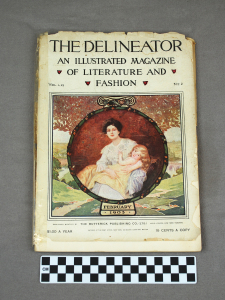This object is an issue of The Delineator: An Illustrated Magazine of Literature and Fashion, Vol. LXI No. 2, published February of 1903. The Delineator was a women’s magazine printed by the Butterick Publishing Company to promote their sewing patterns. It was first published in 1873 when the company combined The Ladies Quarterly with Metropolitan Monthly. The original cost of the magazine was 15 cents each, or $1 annually. The magazine was published on a monthly basis until 1937. Butterick also published books about homemaking, sewing, and cooking that were advertised in the magazine.
The first women’s magazine ever published in the United States was The Ladys Magazine in 1792. At first, fashion was the major topic of women’s magazines. As the popularity of magazines began to increase, writing became an acceptable occupation for women. By the 1800’s, when The Delineator first began publication, women’s magazines started to shift their focus to topics like home economics and family life.
Under the leadership of editor Charles Dwyer in 1814, The Delineator started to cover health issues and the arts. Dwyer used the magazine to campaign for the education of consumers on sanitation and health issues. By 1902, The Delineator was being published in 5 different languages. Around the same time, the Ladies’ Home Journal became the first U.S. magazine with more than one million subscribers. During its publication, The Delineator became a proponent for the women’s rights movement, including but not limited to, lobbying for suffrage. Editors Theodore Dreiser (beginning in 1907) and William Hard (beginning in 1910) expanded the scope of the magazine to include social issues. Dreiser’s “Delineator Child-Rescue” campaign featured the photos and stories of children in need of a home. The campaign ran from 1907 to 1911 and was successful in finding homes for over 2,000 orphaned and abandoned children across the United States. As Editor, Hard promoted the legal rights of women with three monthly columns under the heading “With All My Worldly Goods I Thee Endow.” By 1916, The Delineator was one of the so called “Big Six.” Of the top ten magazines with the highest circulation that year, six were women’s magazines.
From 1921-1926 Marie Mattingly Maloney was The Delineator’s first female editor. Marie was born in 1878 in Bardstown, Kentucky. She took her first job as a reporter for The Washington Post in 1895 and by 1897 was hired as Chief of the Washington Bureau of The Denver Post at just 18 years old. Between 1900 and 1904 she worked at several New York papers before she took time off to stay at home. She returned as editor of the Woman’s Magazine in 1914 and worked at Everybody’s until 1920. During her time as editor of The Delineator, the magazine launched a campaign that raised $100,000 to assist Marie Curie in purchasing a gram of radium for her research. In relative value, $100,000 in 1920 would be roughly equivalent to $1,180,000 today. Marie Curie is known for her work on radioactivity and was the first woman to receive the Nobel Prize in Physics in 1903 as well as a second Nobel Prize in Chemistry in 1911.
In 1928, The Delineator discontinued its publication when it merged with The Designer. Originally intended to advertise Butterick patterns, over the span of its publication The Delineator developed into an important women’s magazine whose scope covered everything from home life to social reform.
